Publish Date (HKT) 2020-12-23
[UNSUBSTANTIATED] Did 47 Chinese workers inoculated with Chinese vaccine test positive for COVID-19 in Uganda?

A screenshot of the LIHKG article

Outline
- An article shared on the LIHKG.com forum claimed that 47 Chinese workers who had been inoculated with the Chinese vaccine in Uganda, Africa tested positive for COVID-19.
- It is confirmed by a press release of the Embassy of the People’s Republic of China in Uganda that 47 Chinese workers for a contracted project in Uganda had tested positive for COVID-19.
- The Ministry of Health of Uganda has approved a request by Chinese residents to import 4,000 doses of the Chinese vaccine from their home country for their own use. These residents reside in the Kapeeka Industrial Park, which does not align with the information in the Chinese Embassy’s announcement.
- A Chinese state media also cited an anonymous source claiming these 47 workers had not been vaccinated. Due to its anonymity, the credibility of the report is unsubstantiated.
- Therefore, we rate the claim UNSUBSTANTIATED.
News Brief
On Dec. 7, 2020, a Taiwanese newspaper the Liberty Times released a news report, claiming that the myths of efficacy of Chinese vaccines has been debunked, because 47 workers in Uganda inoculated with Chinese vaccines tested positive for COVID-19.
The report emphasized that the Chinese vaccine had been administered to overseas Chinese workers, especially those stationed outside China by the government since June 2020. The report made such a claim in accordance with a gazette of the Chinese government which stated, “overseas workers are the main target group for inoculation, and those in Uganda should have received the vaccine.”
Netizens shared the report on LIHKG.com forum on Dec. 8, 2020. The post has received over 800 likes and nearly 200 replies.
Fact-Checking
The claim questions: Is it true that 47 Chinese workers in Uganda tested positive for COIVD-19 after receiving the Chinese vaccine?
The Embassy of the People’s Republic of China in Uganda issued a press release on Dec. 5, 2020, announcing that 47 Chinese nationals working on a project in Uganda on contract by an Indian company had tested positive for COVID-19, confirming the claim as partially true.
However, had these 47 infected Chinese workers been inoculated with the Chinese vaccines?
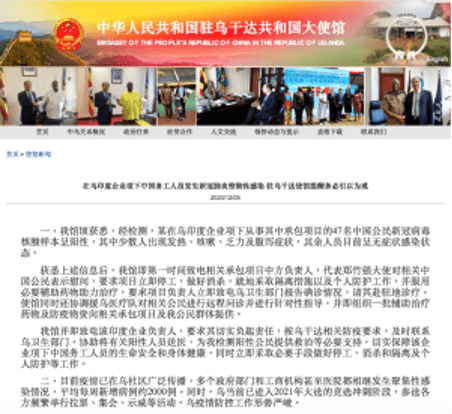
A screenshot of the press release from the Embassy of the People’s Republic of China in Uganda on December 5, 2020
On December 7, 2020, the Chinese Embassy in Uganda issued another press release, which stated, “the relevant Chinese vaccines for COVID-19 are still undergoing Phase III clinical trials and have not yet been officially approved for public use except for emergency use approved by the government, any individual or group shall not purchase, transfer or use them now.”
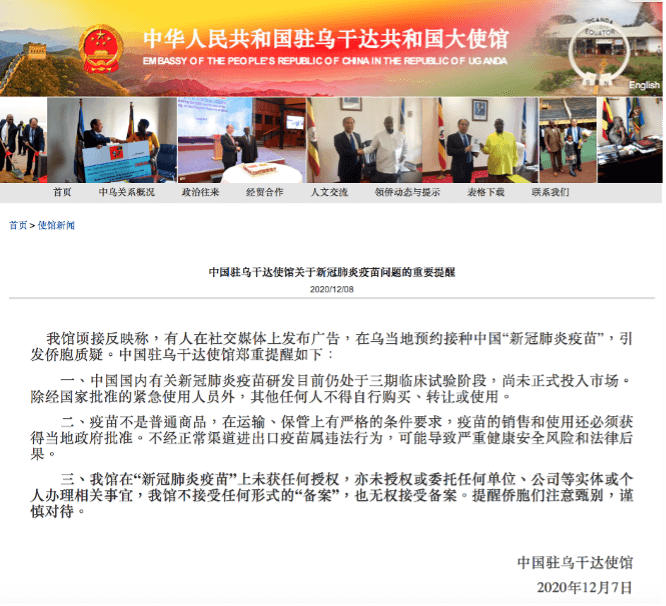
A screenshot of the press release from the Embassy of the People’s Republic of China in Uganda on December 7, 2020
We have found that the Ministry of Health in Uganda officially tweeted on Dec. 9, 2020, announcing that the government is not importing the Chinese vaccine for Ugandans but for the Chinese nationals living in the Kapeeka region, and the Chinese residents in Kapeeka want to import these vaccines for their use only.
The Africanews reported on December 9, 2020, the abovementioned Chinese nationals are the Chinese businessmen located in the Liao Shen Industrial Park in central Uganda.
However, it is still not officially confirmed if the abovementioned vaccinated Chinese nationals fall into the category of “emergency use approved by the government” in the Embassy’s announcement.
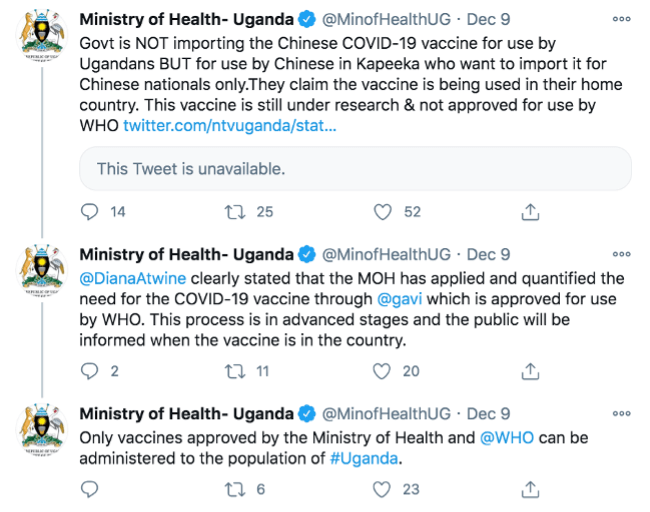
A screenshot of the official tweets from the Ministry of Health of Uganda regarding the import of Chinese COVID-19 vaccine
BBC Monitoring cited a report from the Nile Post, stating that Uganda had allowed Chinese nationals to import 4,000 doses of COVID-19 vaccine for use by Chinese residents of Kapeeka industrial park only.
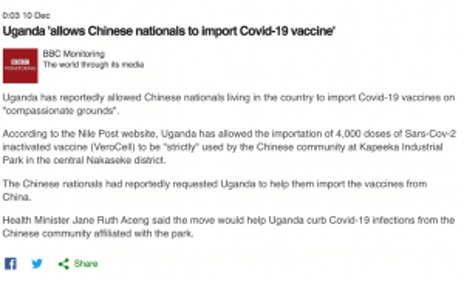
A screenshot of the BBC Monitoring report
Google Maps shows Liao Shen Industrial Park is located in the Kapeeka area. This confirms that the industrial park, where the Chinese vaccine was granted, is located in the inland region of central Uganda, northwest of the country’s capital, Kampala. According to a Bloomberg report released on Dec. 9, 2020, the industrial zone where the Chinese vaccine was being provided is located about 58 kilometres from Kampala.
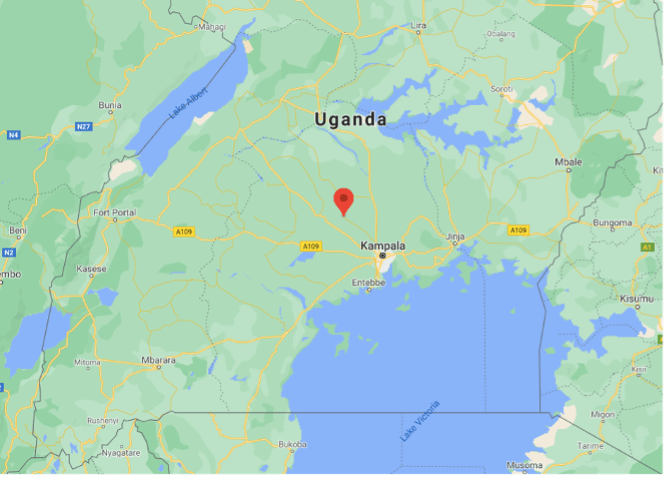
A screenshot of Liao Shen Industrial Park’s location on Google maps
According to a report from the Chinese state media Global Times, the factory where the infected Chinese are working is located near Lake Victoria, more than 10 kilometres from Entebbe airport and more than 30 kilometres from the capital Kampala. Based on this information, the location should be south of Kampala which does not align with the location of Liao Shen Industrial Park.
In addition, the Global Times report anonymously quoted a member of the Chinese medical team saying that the infected Chinese workers had not received the Chinese vaccine and arrived in Uganda last year. Due to its anonymity, the veracity of this information remains questionable. An attempt has been made to source other reliable information but it could not be done prior to the issuance of this report.

A screenshot of the anonymous statement in the report of the Global Times
Therefore, no reliable evidence can substantiate the claim.
Conclusion
It has been confirmed by the press releases from the Chinese Embassy in Uganda that 47 Chinese workers for a contracted project in Uganda had tested positive for COVID-19.
Uganda allowed Chinese nationals to import 4,000 doses of the Chinese vaccine for the use of those residing in the Kapeeka Industrial Park only. The location of the industrial park, however, does not align with the information in the press release from the Chinese Embassy in Uganda. Furthermore, an unreliable anonymous source in the Global Times report said that these workers had not been vaccinated.
Since there is no other reliable information to substantiate this claim, we rate the claim UNSUBSTANTIATED.
References
- The Liberty Times, “Debunking the myths of Chinese vaccine: 47 Chinese workers in Uganda tested positive with COVID-19,” December 7, 2020
- The post on the LIHKG.com’s “Current Affairs” Board, December 8, 2020
- The Embassy of the People’s Republic of China in Uganda, Press Release, “Chinese workers in a project contracted by an indian enterprise in Uganda were infected with COVID-19 due to cluster infection,” December 5, 2020
- The Embassy of the People’s Republic of China in Uganda, Press Release, “Important reminder from the Chinese embassy in Uganda on the issue of COVID-19 vaccine,” December 7, 2020
- Ministry of Health in Uganda’s official tweets on the import of the Chinese vaccine, December 9, 2020.
- Africanews, “Uganda authorizes Chinese nationals to import COVID-19 vaccine for own use,” December 9, 2020
- BBC Monitoring, “Uganda allows Chinese nationals to import COVID-19 vaccine,” December 10, 2020
- Bloomberg, “Uganda allows Chinese residents to import COVID-19 vaccine,” December 9, 2020
- Global Times, “47 Chinese workers infected in Uganda not vaccinated: sources,” December 8, 2020







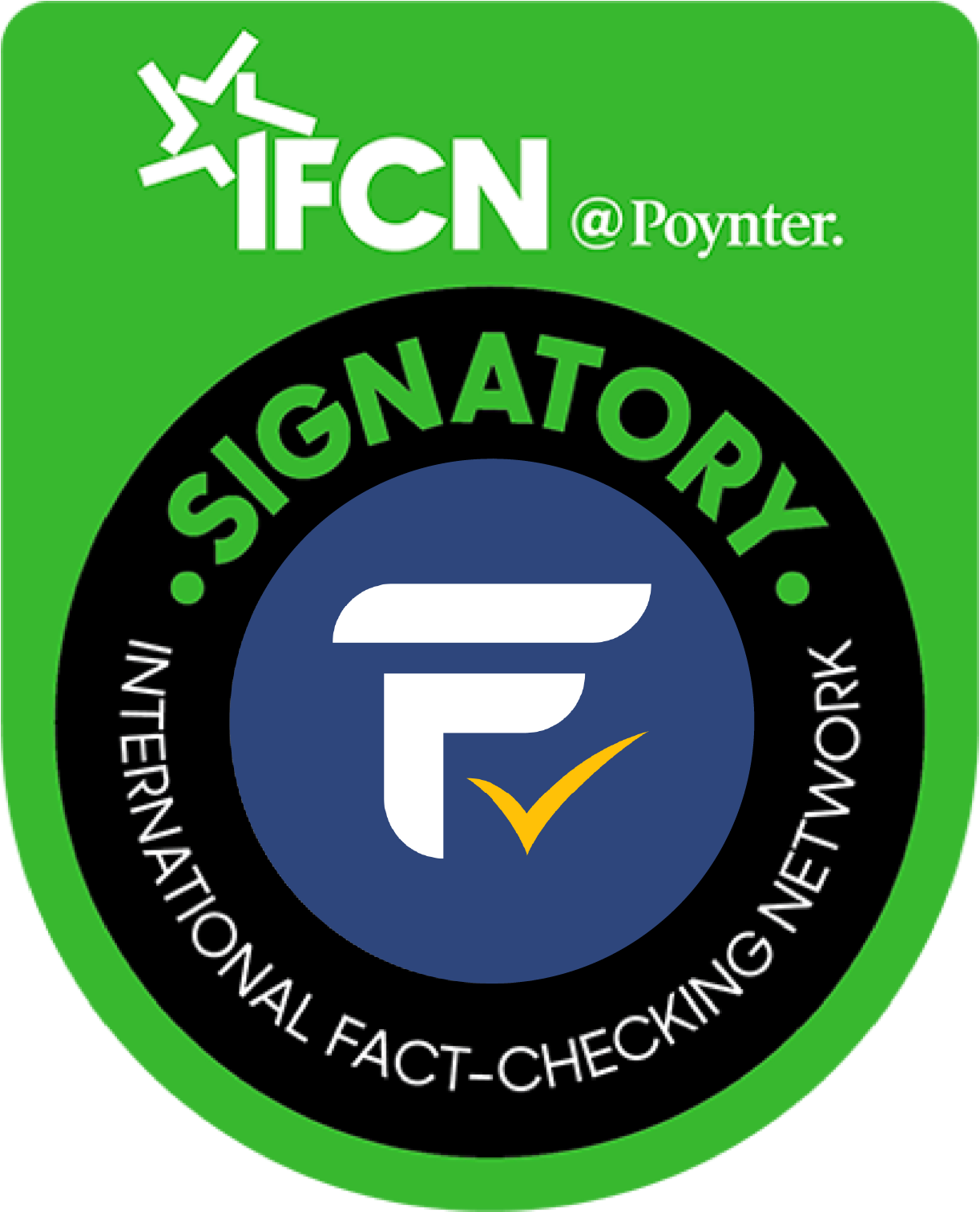




 :
:  : 3411 7375
: 3411 7375 :
: